PDFWAC 296-24-24501
Definitions.
A-frame derrick. A derrick in which the boom is hinged from a cross member between the bottom ends of two upright members spread apart at the lower ends and joined at the top; the boom point secured to the junction of the side members, and the side members are braced or guyed from this junction point.
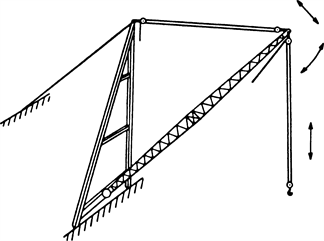 |
a-frame
ANSI. The American National Standards Institute.
Appointed. Assigned specific responsibilities by the employer or the employer's representative.
Basket derrick. A derrick without a boom, similar to a gin pole with its base supported by ropes attached to corner posts or other parts of the structure. The base is at a lower elevation than its supports. The location of the base of a basket derrick can be changed by varying the length of the rope supports. The top of the pole is secured with multiple reeved guys to position the top of the pole to the desired location by varying the length of the upper guy lines. The load is raised and lowered by ropes through a sheave or block secured to the top of the pole.
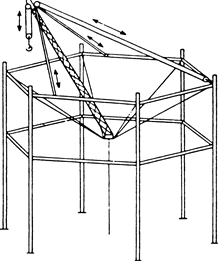 |
basket
Boom. A timber or metal section or strut, pivoted or hinged at the heel (lower end) at a location fixed in height on a frame or mast or vertical member, and with its point (upper end) supported by chains, ropes, or rods to the upper end of the frame mast, or vertical member. A rope for raising and lowering the load is reeved through sheaves or a block at the boom point. The length of the boom must be taken as the straight line distance between the axis of the foot pin and the axis of the boom point sheave pin, or where used, the axis of the upper load block attachment pin.
Boom harness. The block and sheave arrangement on the boom point to which the topping lift cable is reeved for lowering and raising the boom.
Boom point. Is outward end of the top section of the boom.
Breast derrick. A derrick without boom. The mast consists of two side members spread farther apart at the base than at the top and tied together at top and bottom by rigid members. The mast is prevented from tipping forward by guys connected to its top. The load is raised and lowered by ropes through a sheave or block secured to the top crosspiece.
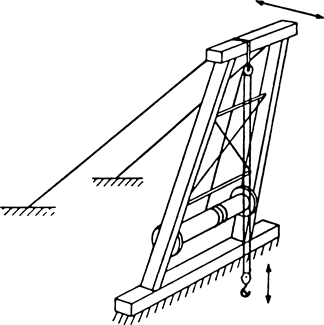 |
breast
Chicago boom derrick. A boom which is attached to a structure, and outside upright member of the structure serving as the mast, and the boom being stepped in a fixed socket clamped to the upright. The derrick is complete with load, boom, and boom point swing line falls.
 |
chicago boom
Derrick. An apparatus consisting of a mast or equivalent member held at the head by guys or braces, with or without a boom, for use with a hoisting mechanism and operating ropes.
Derrick bullwheel. A horizontal ring or wheel, fastened to the foot of a derrick, for the purpose of turning the derrick by means of ropes leading from this wheel to a powered drum.
Designated. Selected or assigned by the employer or employer's representative as being qualified to perform specific duties.
Eye. A loop formed at the end of a rope by securing the dead end to the live end at the base of the loop.
Fiddle block. A block consisting of two sheaves in the same plane held in place by the same cheek plates.
Foot bearing or foot block (sill block). The lower support on which the mast rotates.
Gin pole derrick. A derrick without a boom. Its guys are so arranged from its top as to permit leaning the mast in any direction. The load is raised and lowered by ropes reeved through sheaves or blocks at the top of the mast.
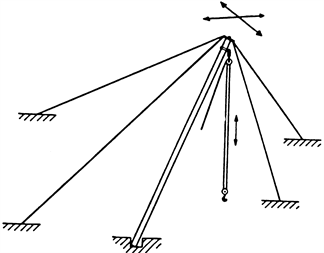 |
gin pole
Gudgeon pin. A pin connecting the mast cap to the mast allowing rotation of the mast.
Guy. A rope used to steady or secure the mast or other member in the desired position.
Guy derrick. A fixed derrick consisting of a mast capable of being rotated, supported in a vertical position by guys, and a boom whose bottom end is hinged or pivoted to move in a vertical plane with a reeved rope between the head of the mast and the boom point for raising and lowering the boom, and a reeved rope from the boom point for raising and lowering the load.
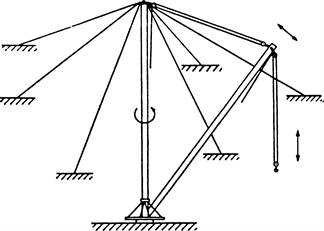 |
guy
Load block, lower. The assembly of sheaves, pins, and frame suspended by the hoisting rope.
Load block, upper. The assembly of sheaves, pins, and frame suspended from the boom.
Load, working. The external load, in pounds, applied to the derrick, including the weight of load attaching equipment such as load blocks, shackles, and slings.
Mast. The upright member of the derrick.
Mast cap (spider). The fitting at the top of the mast to which the guys are connected.
Reeving. A rope system in which the rope travels around drums and sheaves.
Rope. Refers to wire rope unless otherwise specified.
Safety hook. A hook with a latch to prevent slings or load from accidentally slipping off the hook.
Shearleg derrick. A derrick without a boom and similar to a breast derrick. The mast, wide at the bottom and narrow at the top, is hinged at the bottom and has its top secured by a multiple reeved guy to permit handling loads at various radii by means of load tackle suspended from the mast top.
Side loading. A load applied at an angle to the vertical plane of the boom.
Sill. A member connecting the foot block and stiffleg or a member connecting the lower ends of a double member mast.
Standby derrick. A derrick not in regular service which is used occasionally or intermittently as required.
Stiff leg. A rigid member supporting the mast at the head.
Stiffleg derrick. A derrick similar to a guy derrick except that the mast is supported or held in place by two or more stiff members, called stifflegs, which are capable of resisting either tensile or compressive forces. Sills are generally provided to connect the lower ends of the stifflegs to the foot of the mast.
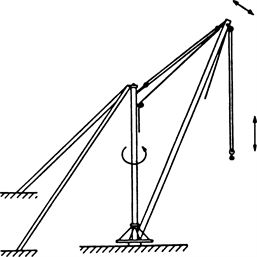 |
stiff leg
Swing. Rotation of the mast and/or boom for movements of loads in a horizontal direction about the axis of rotation.